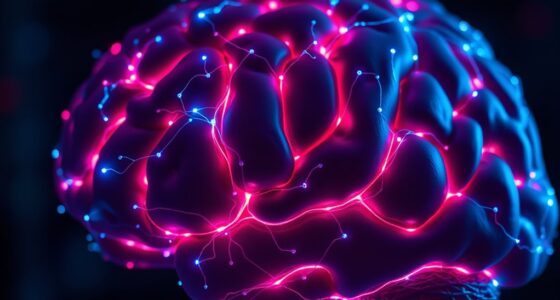In 2025, science has uncovered how sex addiction involves dysregulated brain circuits, especially in dopamine reward pathways. Researchers developed non-invasive treatments like transcranial magnetic stimulation (TMS) to recalibrate abnormal activity. Personalized therapies based on neuroimaging and genetic data now offer better outcomes. Advances also refine behavioral treatments with neurobiological insights. To discover how these breakthroughs could impact recovery strategies and future innovations, continue exploring the latest findings shaping this evolving field.
Key Takeaways
- 2025 research reveals specific neural circuit dysregulation underlying sex addiction, highlighting hyperactive reward pathways.
- Advances include non-invasive neuromodulation techniques like TMS to recalibrate abnormal brain activity associated with compulsive behaviors.
- Personalized treatments now incorporate neuroimaging and genetic data to improve intervention precision and outcomes.
- Neuroscience-informed therapies, such as refined CBT, target neurobiological triggers to enhance recovery effectiveness.
- Integrating biological and psychological models is shaping innovative, holistic approaches to understanding and treating sex addiction.

Have you wondered what groundbreaking discoveries 2025 has brought to science and technology? This year, researchers have made significant strides in understanding sex addiction, revealing new insights into its neurobiological mechanisms and paving the way for innovative treatments. As you explore these advances, you’ll see how they could transform the way we approach mental health and behavioral disorders.
Scientists have uncovered more about the neurobiological mechanisms behind sex addiction, showing how certain brain circuits become hyperactive or dysregulated. These findings point to specific areas, like the reward system involving dopamine pathways, that are altered in individuals struggling with compulsive sexual behaviors. By mapping these neural changes, researchers gain a clearer picture of what drives the compulsive urges and how they differ from healthy sexual expression. This deeper understanding allows for more targeted interventions, moving beyond merely managing symptoms to addressing the root causes at a biological level.
Alongside these discoveries, treatment innovations are emerging that could dramatically improve outcomes for those affected. One of the most promising developments involves neuromodulation techniques, such as transcranial magnetic stimulation (TMS), which can recalibrate abnormal brain activity associated with sex addiction. These non-invasive procedures are gaining traction because they offer a way to directly influence neural circuits without medication or invasive surgery. Additionally, advances in pharmacology are leading to the development of drugs that specifically target the neurochemical imbalances observed in sex addiction. These medications aim to reduce compulsive urges, making therapy more effective and sustainable.
Moreover, researchers are exploring personalized treatment plans based on individual neurobiological profiles. By combining neuroimaging data and genetic markers, clinicians can tailor interventions that address each person’s unique neural patterns. This precision approach promises higher success rates and fewer side effects. In addition, understanding the offensive security methodologies used by ethical hackers can inform new strategies for protecting these delicate neural networks from cyber threats, ensuring the integrity of mental health interventions. Alongside pharmacological and neuromodulation strategies, behavioral therapies are also evolving, incorporating insights from neuroscience to enhance their efficacy. Techniques like cognitive-behavioral therapy (CBT) are being refined to better target the underlying neurobiological triggers, helping patients develop healthier coping mechanisms.
All these advancements signify a shift towards a more integrated understanding of sex addiction, one that considers both biological and psychological factors. As you follow these developments, it’s clear that 2025 isn’t just about discovering new knowledge—it’s about translating that knowledge into meaningful, effective treatments. The convergence of neurobiological insights and treatment innovations promises hope for many, offering new pathways to recovery rooted in the latest scientific understanding.
Frequently Asked Questions
How Effective Are Current Treatments for Sex Addiction?
Current treatments for sex addiction show promising results, thanks to therapy advancements that focus on behavioral change and emotional regulation. You’ll find that treatment efficacy varies, but many individuals experience reduced symptoms and better control over impulses. Cognitive-behavioral therapy and support groups are particularly effective, helping you understand underlying issues and develop healthier habits. While no treatment guarantees complete recovery, many people benefit considerably from these approaches.
What Are the Latest Breakthroughs in Understanding Sex Addiction Causes?
Imagine your brain as a garden, where neuroplasticity implications shape how habits grow. Recent breakthroughs reveal that sex addiction stems from these neural pathways, reinforced by social stigma that keeps the issue hidden. Understanding that the brain can rewire offers hope for recovery. You can break free by addressing these deep-rooted patterns, challenging societal judgments, and nurturing healthier connections—transforming your mental landscape into a resilient, flourishing space.
Can Sex Addiction Be Completely Cured or Only Managed?
You can manage sex addiction effectively, but complete cure isn’t guaranteed. With behavioral therapy, you learn to identify and change harmful patterns, while social support offers encouragement and accountability. Staying committed to ongoing treatment and building a strong support network increases your chances of controlling urges and maintaining a healthier lifestyle. Remember, recovery is a journey, and consistent effort with professional help makes a significant difference.
How Does Genetics Influence Sex Addiction Risk?
Genetics weave a subtle thread into your risk for sex addiction, like a hidden map guiding your tendencies. If you have a genetic predisposition or inherited traits, you might find yourself more vulnerable to compulsive behaviors. These inherited traits act as a foundation, shaping your brain’s wiring and responses. Recognizing this genetic influence helps you understand your vulnerabilities and empowers you to seek targeted support and strategies.
What Role Does Neuroscience Play in Sex Addiction Research?
Neuroscience helps you understand sex addiction by examining neural pathways involved in compulsive behaviors. Brain imaging techniques reveal how certain areas, like the reward system, become hyperactive or dysregulated. This research shows you how addiction hijacks your brain’s circuitry, making it harder to resist urges. By mapping these neural pathways, scientists develop targeted treatments to help you regain control and reduce compulsive sexual behaviors.
Conclusion
As science uncovers new insights, you gain a clearer understanding of sex addiction. You see its complexities, recognize its challenges, and appreciate its nuances. You understand the importance of compassion, the power of treatment, and the promise of hope. With each discovery, you become more aware, more informed, more prepared. Embrace this knowledge, continue to learn, and remember: understanding fosters empathy, empathy fosters healing, and healing transforms lives.









